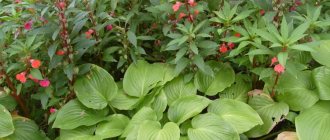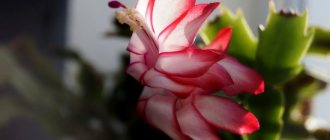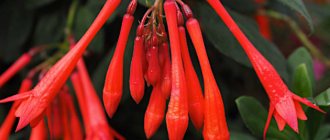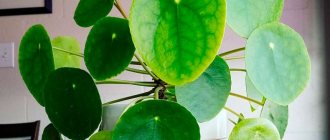Waller's balsam (Impatiens walleriana), also known as “impatiens”, is a herbaceous plant of the balsam family, with wide, alternate jagged leaves of a dark green or reddish color, about 60 cm high.
Impatiens is native to the tropical zones of Africa and Asia, since 1596 became widespread in Europe and America. Its flowers, simple or double, are arranged singly and have a bright palette of various shades, except yellow and blue. After the bud fades, the plant forms a fruit-box, which easily opens, releasing a large number of small seeds.
Impatiens is a fast-growing perennial that blooms most of the year. When propagated already in the third month after germination, balsam produces the first flowering.
Also be sure to check out how to grow apthenia at home.
| The growth rate is high. |
| Blooms from early winter to early spring. |
| The plant is easy to grow. |
| It is a perennial plant. |
Caring for balsam at home. Briefly
At home, balsam is a fairly simple and low-maintenance flower. Basic rules for keeping balsam:
| Temperature | In the summer months - no more than 21 ºС, in winter - from 10 to 16 ºС. |
| Air humidity | High humidity up to 80% is preferred. |
| Lighting | Regular abundant hydration at any time of the year. |
| Watering | The substrate must be kept moist at all times. |
| Priming | A permeable nutrient mixture of turf, humus, peat and sand with a drainage layer. |
| Feeding and fertilizer | During the growing season it requires liquid mineral fertilizers. |
| Impatiens transplant | Held annually, every spring. |
| Reproduction | Quite easily propagated by both cuttings and seedlings. |
| Features of growing balsam | Periodic pruning or pinching of shoots is required annually. It is susceptible to frequent pests and does not tolerate sudden temperature changes. |
Balsam family – Balsaminaceae
A beautiful flowering plant. Impatiens are also known under other common names: evergreen, sparkle, and impatiens. They all reflect different features of this plant. The genus balsam includes about 400 species in total. The variety of balsams is so great that it is difficult to give them an accurate general description - they are annuals, perennials, herbaceous, and semi-shrub forms. The stems of balsams are juicy, fleshy, often translucent - in this way they resemble succulents.
Balsam: care at home Details
Impatiens flowering
In favorable conditions, balsam flowering continues almost all year round, from early spring until December.
Its flowers, with a diameter of 4 to 6 cm, depending on the variety, can be single, with spurs, few-flowered, in the form of axillary inflorescences, and sometimes located on elongated pedicels. The rich color palette of the plant allows it to be used as a decorative decoration for rooms, balconies, and terraces. In addition, balsam is often planted on the site as a garden annual.
Before rain or after heavy watering, balsam leaves secrete transparent drops of juice, which, after drying, turn into sugary crystals. Under natural conditions, this protects the plant's pollen from ants.
Flowers of ampelous varieties of balsam look great in hanging flower pots and flowerpots.
Temperature
Homemade balsam feels most comfortable in moderately warm conditions - without drafts, hot temperatures and dry air. In the summer, it is favorable for it to be on non-sunny glazed loggias and balconies; in winter, it is better to place it in a moderately lit room with a temperature of 15-18 ºС.
Spraying
The balsam plant at home loves high humidity and it can only be ensured in hot summer conditions by regularly spraying the plant. To do this, use soft, settled water, spraying moisture onto the ground and leaves, avoiding contact with the flowers.
Lighting
This is an extremely light-loving plant, but it should be protected from the scorching sun. East windows and places with soft sunlight are perfect. In winter, additional lighting is provided for at least 14 hours a day using special lamps.
With the onset of the rest period, illumination should be reduced.
Watering balsam
Water the flower exactly as much as is required to completely moisten the soil.
If you allow the earthen ball with its root system to dry out, the balsam drops its buds and the edges of the leaves dry out. In winter, the amount of water should be reduced, but still not allowing the soil to dry out. For irrigation, softened, as well as rain or melt water heated slightly above room temperature is used.
Balsam pot
For regular abundant flowering of balsam, it is placed in a medium-sized, even slightly cramped flower pot. As a rule, this is a container with a diameter of 17 cm, which will allow the flower to direct its forces specifically to the formation of buds, and not to the development of the root system. In addition, pots that are too large cause rot on the roots due to acidification of the soil.
Priming
At home, balsam takes root well in universal soil, but slightly acidic soil of the following composition is also used:
- turf land (1 part)
- sand or perlite (1 part)
- leaf soil (3 parts)
Regardless of the type of soil, a drainage layer consisting of charcoal or expanded clay is required.
Feeding and fertilizer
Impatiens will benefit from liquid phosphorus-potassium mineral fertilizers, which will support the plant during the growing season and ensure lush growth and flowering. These products are fed once every 10 days, through watering or spraying. Impatiens does not tolerate organic additives.
Also, you should not fertilize the flower during the dormant period or during illness.
Transfer
Balsam is transplanted annually in spring into small containers of regular size.
More often, the transfer method is used, in which the flower bush is carefully removed from the pot without shaking off the soil at the roots, then placed in a new container, followed by filling the resulting voids with new soil. The root collar of the plant is not covered with soil. After watering, the newly planted balsam is placed in the shade and taken out to its usual place only after three days.
During the flowering period, balsam cannot be replanted, otherwise it will shed existing buds and stop growing.
How to prune balsam?
Caring for balsam at home also involves pruning the shoots of the plant, which is carried out simultaneously with replanting. This is necessary not only to form a neat spherical shape, but also to rejuvenate the plant, stimulating its growth and flowering.
In addition to pruning, bare elongated shoots are regularly pinched, leaving 3 buds on the branch. Cuttings can be placed in water for rooting.
Rest period
The rest period for balsam is often forced. In sunny regions with a mild climate, the plant can bloom all year round. And in cold areas, the flower goes to a shaded place for the winter from October or December to February.
Conditions during this period: air temperature not higher than 15-18 ºС, moderate watering, excluding fertilizing and spraying.
Species affiliation
The Balsam family (Balsaminaceae) is divided into two genera - Hydrocera and, in fact, Balsam, otherwise - Impatiens. There is only one representative of the genus Hydrocera - the species of the same name Hydrozera, an inhabitant of swamps. The Impatiens genus is much more numerous - about 500 species, of which no more than a dozen are used in decorative floriculture. Many members of the family are poisonous plants.
Various species of the Impatiens genus live throughout the globe. Most of them settled in the tropical rainforests of the African continent and Indochina, on the islands of Madagascar and Sumatra. New Guinea forms of balsam, which are distinguished by their love of light, have widely taken root in culture.
However, representatives of the genus Impatiens can be found in temperate climates, right up to the belt of dark coniferous taiga forests. In Central Siberia, a close relative of the indoor balsam grows - forest balsam (I. noli-tangere), valued by the local population for its medicinal properties.
Home balsam, Wallera (I.walleriana): appearance
As a houseplant, not just one species is cultivated, but a whole group, under the general name Waller's Balsam. These are compact bushes, 20-50 cm high, with shiny foliage, green or reddish-bronze. The flowers are irregular, with a long spur, 2-4 cm in diameter, simple or double.
The group of species Implatiens walleriana includes, among others, Balsam sultana, with green leaves and translucent young shoots. The double flowers of Balsamum sultanaforme resemble miniature roses. Another representative - I.holstii, Holst's Impatiens - is popularly called Ogonyok, for its bright red flowers, effectively “burning” against the background of its dark bronze foliage.
In Russia, the variety of balsam described above is mainly grown. In gardens, garden balsam is occasionally found, which is called Impatiens balsam. In Europe, hybrids of Hawker's Balsam are popular, the African species - Impatiens Niamey - with a very exotic, "parrot" coloring, creeping form - I.repens, with yellow flowers, and many others.
Growing balsam from seeds
One of the features of this flower is the ripening of the capsule fruit, which cracks upon any contact from the outside, releasing many seeds that remain viable for up to 8 years. The soil for sowing must be sifted and disinfected. This can be either just a peat-sand mixture, or a substrate of garden soil mixed with sand. Usually sowing is carried out in April-May, but some varieties of balsam, for example, New Guinea hybrid, can be sown as early as January.
Technique for sowing balsam seeds:
- the prepared substrate is laid out in small containers and moistened with a spray bottle;
- the seeds are laid out on the surface of the ground so that the distance between them is about 3-4 cm;
- It is not recommended to sprinkle the seeds completely, only lightly with sand or sifted soil;
- After moistening the crops, greenhouse conditions are created.
After 5-15 days you can expect the plant to sprout. When they reach a size of 1 cm, having a pair of full leaves, this is an indicator that it is time to dive.
In order to admire the flowering of young balsam in the summer, it is worth sowing seedlings in early March.
Reviews
- Katerina, 26 years old: “I fell in love with balsam in one of the flower shops, but the price for an adult plant at that time was too high for me, and I decided to grow it myself. I bought seeds in the same store, they were securely hidden in a paper bag that contained a capsule, it contained several small seeds, they were so airy, I was afraid that in any draft they would fly off the pot, because digging them in when planting is not recommended. After the first watering of the soil with a spray bottle, the seeds themselves were pressed into the ground. The first shoots appeared after about three weeks, I already began to worry that they had not sprouted at all. After they grew and were decorated with wide leaves, I transplanted them into peat cups. Some had to be planted in twos because I couldn’t separate their roots. As a result, on my balcony there were three hanging flower pots with hanging thick branches, densely strewn with flowers.” But you can find out what reviews of Balsam Camellia exist by reading this article.
- Olga, 54 years old: “In a garden store I liked a bag of seeds of the terry ampelous balsam variety “ATENA APPLEBLOSSE F1.” There were only 8 seeds in it. Since I had never sprouted seedlings for flowers from seeds, I approached this process with all seriousness. I prepared a special mixture, poured it into a shallow container, and placed the seeds in two rows at a decent distance from each other. Periodically sprayed the ground. And when the entrances appeared, I carefully watched to see that three leaves appeared on them, then transplanted them into small disposable plastic cups. Of the eight seeds, I got five. As soon as the seedlings got stronger, I immediately planted them in hanging pots and hung them on my balcony, it’s glassed, so it’s been decorated with balsam since May.”
Propagation of balsam by cuttings
The easiest and fastest way to propagate balsam is by plant cuttings. For this purpose, in May-June, strong, healthy flower specimens are briefly placed in the shade. As soon as the bush produces several elongated shoots, they are cut off and rooted in water.
Then they are planted in separate containers with a slightly acidic soil mixture. Thus, the flower can be propagated at any time of the year. A plant grown in summer blooms even in winter.
It is worth remembering that young plants need bright lighting, otherwise the sprouts will stretch out greatly without gaining strength and color.
Diseases and pests
When keeping balsam, gardeners often encounter the following problems:
- Balsam leaves wither and fall off. Occurs at temperatures below 10 ºС, as well as when there is a lack of moisture.
- The stems are stretched. The reason is an acute lack of bright lighting.
- The appearance of spots on the leaves. Caused by fungal diseases of the flower.
- The balsam buds are falling. This occurs at too high temperatures, in hot air, and also when the soil dries out.
- Leaves curl and fall off. Lack of minerals, too high soil moisture.
- The leaves become pale. This problem is caused by staying in the shade for a long time, or the appearance of parasitic insects.
- Impatiens does not bloom or blooms poorly. It occurs due to a lack of nutrients or the use of nitrogenous fertilizing, which causes abundant development of foliage.
Balsam pests include spider mites, false scale insects, thrips, and aphids and whiteflies are also common.
Types and varieties of homemade balsam with photos and names
Waller's balsam, or Waller's impatiens, or Waller's impatiens, "impatiens", "Roly-wet", "light", "water fuchsia", (Impatiens hostii, Impatiens walleriana, Impatiens sultanii) - all these are the names of one plant species, which is the source of a numerous series of hybrids. This type is characterized by long and abundant flowering, axillary inflorescences with five petals, finely toothed leaves 12 cm long.
Popular varieties and groups of Waller's balsam
Balsam Series 'Accent F1'. Miniature plants 15-20 cm high, with large flowers of a wide variety of colors.
Balsam Series 'Tempo F1 Hybrid'. The length of the plant's stem ranges from 20 to 25 cm. It is characterized by early vegetation with orange and pink flowers.
Balsam Series 'Stardust F, Mixed'. It has richly colored inflorescences with petals edged in deep red, pink or coral.
Balsam Series 'Bruno F1'. The very first series of flowers with a doubled set of chromosomes. The variety is characterized by high resistance to temperature changes, larger flowers with a diameter of 6 cm, and early seed germination.
Balsam Series 'Firefly'. The plant is a neat, abundantly flowering bush with flowers of purple, scarlet, and peach shades, hiding greenery behind it.
Balsam Series 'Fiesta F1'. It is distinguished by a more branched structure, as well as double one-color or two-color rosette flowers.
New Guinea balsam is a hybrid of Impatiens balsam with a stem height of 30 cm and single flowers with a diameter of 7-8 cm and having spurs.
Popular varieties of New Guinea balsam
Balsam series 'Java'. It has inflorescences of bright “tropical” color framed by rich green foliage.
Balsam series 'Jangle Rain'. Produces flowers in delicate pastel colors.
Balsam series 'Rainforest Exotic'. Bicolor variety with dark green foliage.
Impatiens ampelous: description of the plant
Impatiens is a herbaceous shrub with large, erect stems. The plant's nutrition comes from a large rhizome. The shoots grow quickly and form a spherical bush up to 45 cm high. If the humidity is high, small granules similar to grains of salt appear on the stems.
Plant in a pot
The petals are attached to the stems on small petioles and are oval or ovoid in shape. The size of each petal is approximately 9-14 cm. The edges of the petals are covered with small teeth, and on the surface there is a relief pattern of veins. The leaves are mostly green, but sometimes have a purple tint.
The first flowers begin to grow in early spring and replace each other until mid-winter. The color of the leaves can be bright red, pink, emerald, purple, blue, lilac, orange. There are also species with the usual 5-petaled flowers in the shape of an open bell. There are now many varieties of velvety-looking plants on the market whose flowers look like a small rose.
For your information! A small berry grows in place of the flower. She is very sensitive to touch. Any vibration causes the berries to open and numerous seeds immediately fall from them.











